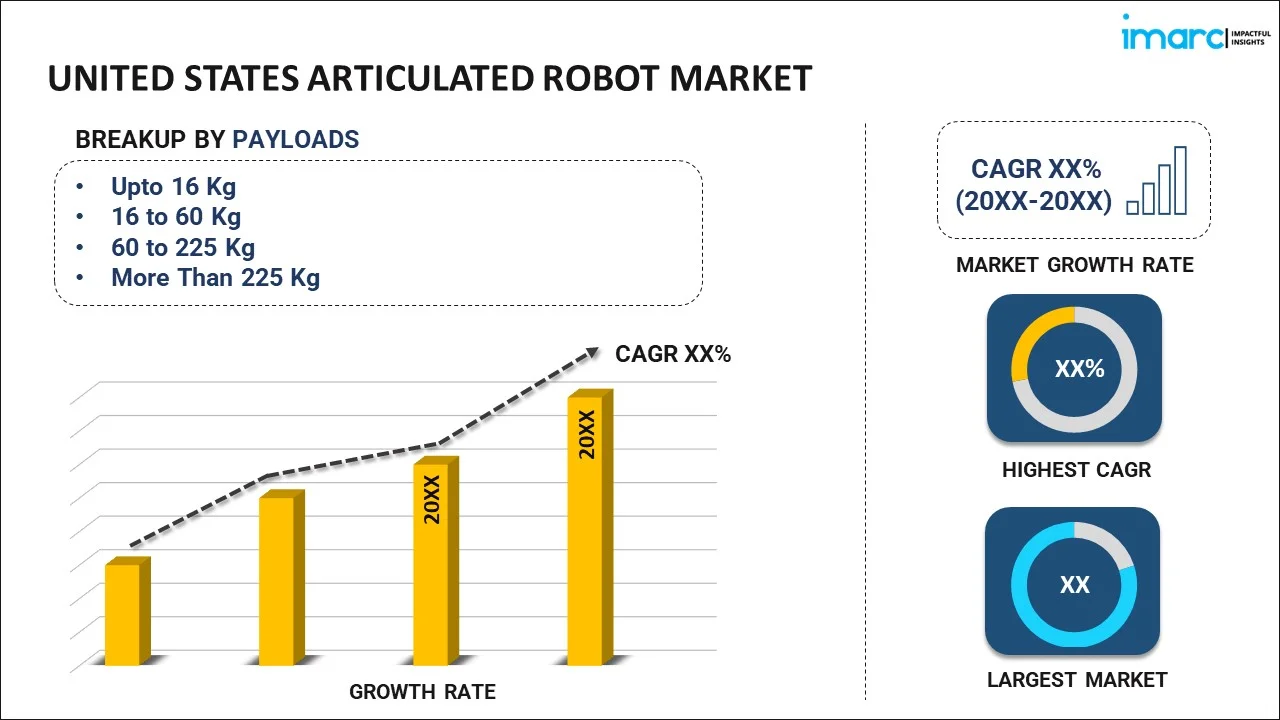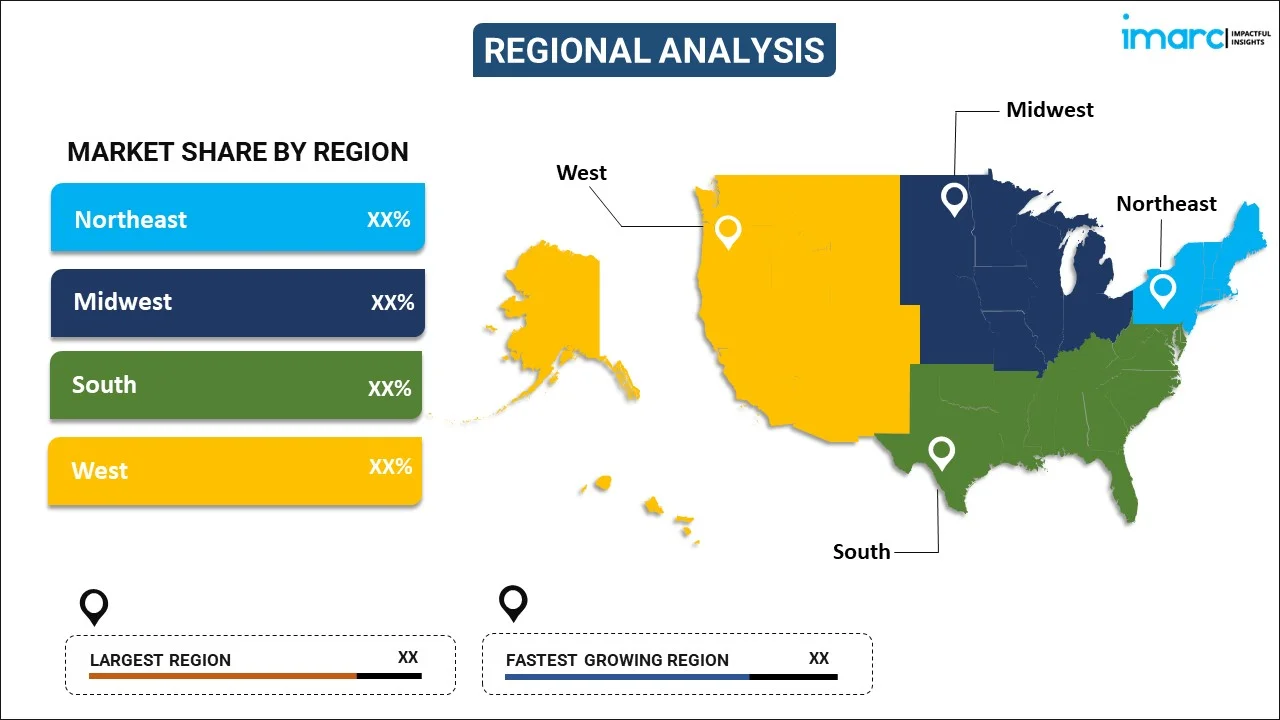
United States Articulated Robot Market Report by Payload (Upto 16 Kg, 16 to 60 Kg, 60 to 225 Kg, More Than 225 Kg), Function (Handling, Welding, Dispensing, Assembling, and Others), Type (4-Axis or Less, 5-Axis, 6-Axis or More), Component (Controller, Arm, End Effector, Drive, Sensor, and Others), End-Use Industry (Automotive, Electrical and Electronics, Chemicals, Rubber and Plastics, Metal and Machinery, Food and Beverages, Precision Engineering and Optics, Pharmaceuticals and Cosmetics, and Others), and Region 2025-2033
Market Overview:
The United States articulated robot market size reached USD 1.8 Billion in 2024. Looking forward, IMARC Group expects the market to reach USD 3.1 Billion by 2033, exhibiting a growth rate (CAGR) of 5.81% during 2025-2033.
|
Report Attribute
|
Key Statistics
|
|---|---|
|
Base Year
|
2024
|
|
Forecast Years
|
2025-2033
|
|
Historical Years
|
2019-2024
|
|
Market Size in 2024
|
USD 1.8 Billion |
|
Market Forecast in 2033
|
USD 3.1 Billion |
| Market Growth Rate 2025-2033 | 5.81% |
An articulated robot refers to an industrial machine consisting of electrically motored rotatory hands, which allow a full range of motion. It is employed for performing various handling tasks, such as welding, dispensing, assembling, cutting, loading/unloading and painting. Articulated robots enhance operational efficiency, generate accurate output, and are highly durable and cost-effective. Owing to these benefits, they are extensively used across the automotive, aerospace, and electronics industries.
One of the key factors driving the United States articulated robot market growth is the rapid establishment of smart factory systems in the country. This, in turn, has increased the product adoption for automation processes across several end use industries. Additionally, the escalating demand for electric vehicles (EVs) across the country is contributing to the market growth. Moreover, rising concerns for labor safety and the increasing need for minimal operational cost and raw material wastage are fueling the market growth. Apart from this, the rising integration of the Internet of Things (IoT) and continuous investments by the Federal Government of the United States in the field of robotics are creating a positive outlook for the market.
Key Market Segmentation:
IMARC Group provides an analysis of the key trends in each sub-segment of the United States articulated robot market report, along with forecasts at the country and regional level from 2025-2033. Our report has categorized the market based on payload, function, type, component and end-use industry.
Breakup by Payload:

- Upto 16 Kg
- 16 to 60 Kg
- 60 to 225 Kg
- More Than 225 Kg
Breakup by Function:
- Handling
- Welding
- Dispensing
- Assembling
- Others
Breakup by Type:
- 4-Axis or Less
- 5-Axis
- 6-Axis or More
Breakup by Component:
- Controller
- Arm
- End Effector
- Drive
- Sensor
- Others
Breakup by End-Use Industry:
- Automotive
- Electrical and Electronics
- Chemicals, Rubber and Plastics
- Metal and Machinery
- Food and Beverages
- Precision Engineering and Optics
- Pharmaceuticals and Cosmetics
- Others
Breakup by Region:

- Northeast
- Midwest
- South
- West
Competitive Landscape:
The competitive landscape of the industry has also been examined along with the profiles of the key players.
Report Coverage:
| Report Features | Details |
|---|---|
| Base Year of the Analysis | 2024 |
| Historical Period | 2019-2024 |
| Forecast Period | 2025-2033 |
| Units | Billion USD |
| Segment Coverage | Payload, Function, Type, Component, End-Use Industry, Region |
| Region Covered | Northeast, Midwest, South, West |
| Customization Scope | 10% Free Customization |
| Post-Sale Analyst Support | 10-12 Weeks |
| Delivery Format | PDF and Excel through Email (We can also provide the editable version of the report in PPT/Word format on special request) |
Key Questions Answered in This Report
The United States articulated robot market was valued at USD 1.8 Billion in 2024.
We expect the United States articulated robot market to exhibit a CAGR of 5.81% during 2025-2033.
The increasing demand for articulated robots across several industries, including automotive, aerospace, and electronics, as they aid to generate accurate output, are highly durable, cost-effective, and require minimal rest, is primarily driving the United States articulated robot market.
The sudden outbreak of the COVID-19 pandemic had led to the implementation of stringent lockdown regulations across the nation, resulting in the temporary closure of numerous manufacturing units for articulated robots.
Based on the payload, the United States articulated robot market can be segmented into upto 16 kg, 16 to 60 kg, 60 to 225 kg, and more than 225 kg. Currently, upto 16 kg accounts for the majority of the total market share.
Based on the function, the United States articulated robot market has been divided into handling, welding, dispensing, assembling, and others. Among these, handling currently holds the largest market share.
Based on the end-use industry, the United States articulated robot market can be bifurcated into automotive, electrical and electronics, chemicals, rubber and plastics, metal and machinery, food and beverages, precision engineering and optics, pharmaceuticals and cosmetics, and others. Currently, automotive exhibits a clear dominance in the market.
On a regional level, the market has been classified into Northeast, Midwest, South, and West, where Midwest currently dominates the United States articulated robot market.
Need more help?
- Speak to our experienced analysts for insights on the current market scenarios.
- Include additional segments and countries to customize the report as per your requirement.
- Gain an unparalleled competitive advantage in your domain by understanding how to utilize the report and positively impacting your operations and revenue.
- For further assistance, please connect with our analysts.
 Inquire Before Buying
Inquire Before Buying
 Speak to an Analyst
Speak to an Analyst
 Request Brochure
Request Brochure
 Request Customization
Request Customization




.webp)




.webp)












